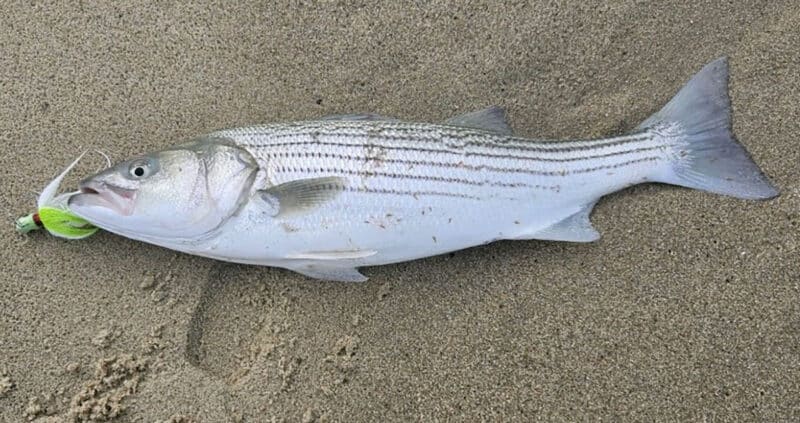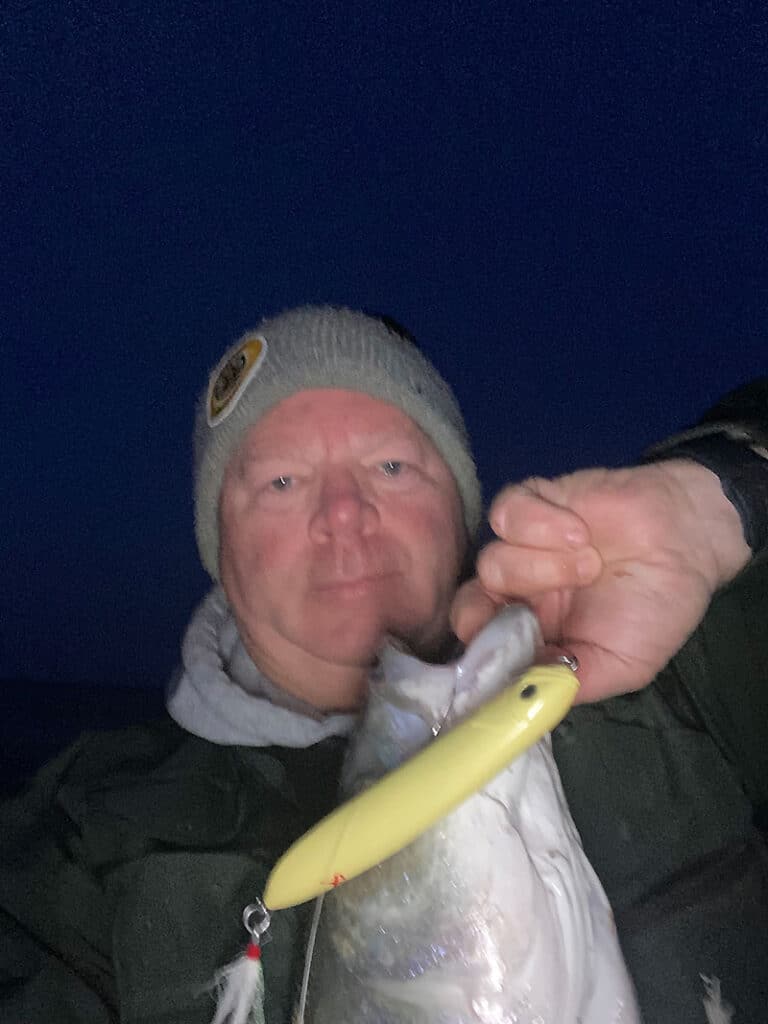by Steve “Tuna” Tornovish
“If you’re not real smart, you need smart friends.” I think this quote comes from Albert Einstein. Or maybe Yogi Berra. Who knows—maybe I said it. Regardless, there’s a lot of truth to this, right? Expert advice is a really great way to go when you want to get a question answered. And I am fortunate enough to have a bunch of smart friends, particularly when the questions involve fishing for striped bass. So it seemed like exactly the right time to ask them a bass fishing question. The question was as follows…
You’re taking a friend out beach fishing for two hours at sunset. They are relatively inexperienced but really want to catch a striped bass. You can give them a rod / reel with one lure and show them how to use it. What lure are you putting on for them and what are you telling them? Needless to say, live bait is not an option.
This text went out to about a dozen of my favorite striped bass fishermen. Almost every one of them responded in short order that the question was inherently unfair. Two-time winner of the Fall Classic fishing tournament Rafael Osona summed up the responses when he said this: “With any question like this, there’s so many variables to consider when choosing a lure. The shoreline, water depth, wind, is it weedy, etc.” Exactly, Raf: the question was intentionally vague. And because of this, you’ve just provided a glimpse into the mind of an expert bass fisherman. Where you are fishing, what kind of beach structure are you fishing around, what is the wind doing, what is the tide—all of these are significant items on the decision matrix. But my friends were urged to give answers to the question as presented. And answer they did, in a bunch of very insightful ways.
Dr. Matt Roberts chimed in: “Fun question! I think sunset on the north shore, giving them a Sluggo, telling them to reel slowly. And then, when they think they’re reeling slow, reel even slower! Twitch, twitch every 5 to 10 seconds.” Very excellent advice from our favorite dentist, indeed!
So let’s break this down, starting with the lure selection. A Sluggo is a soft plastic bait that is pre-rigged with two single in-line hooks molded into the body. When retrieved slowly, the lure falls in a hypnotic manner that resembles a wounded baitfish. The slight twitch of the rod tip that Matt describes will cause the Sluggo to jump up and then decend again. Sluggos are a hard lure to fish incorrectly. They’re best fished in shallow water like the north shore as Matt stipulated. Striped bass love them some Sluggo! As for the downside of using this soft bait, it’s that Sluggos tend to be the ultimate bluefish detectors. Bluefish bite the tails off of their dinner and Sluggos are not built to withstand such savagery. This leads directly to many of us having our truck beds filled with half eaten Sluggos.
Many of my south shore warriors preferred hard plastic lures like the Diawa SP Minnow or the Joe Baggs Swarter for the beginners, including James Hatton, Chuck Duce and John Colton. Those guys really know their stuff. Here’s what Chuck Duce had to say: “Put on an SP Minnow and have them throw it straight out. Reel it in really slow, all the way to your feet. This will teach a beginner to use the swimming lure to understand what the water is doing. Figure out water movement first and then you can figure out where the bait will hold up. This is for in the surf with points and outer bars. Not in the harbor. Tough question to answer!”
Chuck has imparted a lot of wisdom in one little text here. He has the beginner anglers casting straight out in front of them. Beginners need to develop basics, particularly for casting. But it also hints that the experts are generally not casting out straight in front of them. Experienced fishermen are often targeting the deep troughs that run parallel to the beach, so their casts are going to be at an angle much less than the 90 degree that Chuck prescribed for the beginner.
“Reel it in really slow, all the way to your feet.” Many south shore fish are caught right in the wash. Beginners miss a lot of fish by pulling the lure quickly through the last part of that crucial strike zone. “Figure out water movement first, and then you can figure out where the bait will hold up.” Chuck is looking for a deeper section of water where bigger fish will sit and wait to ambush the baitfish. Yeah, this is why Chuck Duce catches a ton of big fish.
My main striped bass fishing partner is Dale Gary. He echoed a lot of what Chuck said, only prescribing a black Joe Baggs Swarter as his main lure for the beginner. “The best tip I can give is to try to get a feel for what your lure is doing as you’re bringing it in.” Dale knows that if he can visualize the way his lure is performing in the water, he’s going to have much more success. It’s a zen-like concept, perhaps, but fishing for striped bass, particularly at night, requires a developed feel. When Dale is dialed in with a lure, he puts a lot of fish on the beach. Ask me how I know—Dale often fishes right beside me and catches way more bass. It’s pretty frustrating!
The funniest response that I received from these questions came from Dr. Greg Chotkowski. He didn’t type a single word. No, Greg’s responses were three consecutive pictures of striped bass choking on bucktail jigs. The bucktail is one of the oldest and most low-tech lures ever developed. It’s certainly deadly to striped bass when in Greg’s hands, however! Stand by for a future column dedicated to this old-school technique!
Dave Small and Dave Bold are my two perennial Spring Sea Run Opener teammates (Go Team Irrelevant Irredeemables!). They both favored the Hogy paddletail lure. Mr. Bold said this: “For a first timer, I would put on a Hogy paddle tail, either white or bunker colored, weight and size appropriate for the wind and current conditions (my go-to is the 2oz size). A Hogy is easy to cast and retrieve for a newbie. Tell them not to worry about trying to cast a long way, but rather focus on a nice even retrieve, and don’t give up till the lure comes out of the water. Lots of fish hit right at the lip so be ready for it all the way to the end of the retrieve.” Hey now, we’ve heard that advice somewhere before, right?
One thing that I found very interesting about this question was that both Dan Holmes and Tammy King, my two fellow beach guides, gave me almost the exact same answer: an amber colored top water lure. Dan said this: “I would go with an Island X Hellfire 180 (but I might change my mind once I get some more time on the Sidewinder XL though) and recommend working it with a variety of actions. Intermittent pauses and some twitching. If it doesn’t do the trick, use a steady, faster retrieval with the rod tip up. The floating version of this lure offers a good variety on ways to work the lure to fit the scenario, not to mention great casting range.”
My brother Billy selected both of those fine Island X products, citing the fact that they are all equipped with single hooks as opposed to the treble hooks that most minnow-style plugs utilize. Joe Uva, the best beach fisherman on Martha’s Vineyard (you know, that other island) liked the surface lure as well. “I would put on a Spook-type (surface) lure. It’s a great time of year to fish that way and the experience of a good top water bite will only ensure that they would be hooked for life! A steady retrieve while popping the rod tip is all that is needed to make these lures work their magic. If a fish goes after the plug, keep working it until the rod comes tight and then set the hook.”
So what’s the main thing that all of this has taught us? It seems clear—a wide variety of lures will produce if you present them properly. When fishing for striped bass, fish slowly. And if nothing else, get out there and give it a try!
Steve “Tuna” Tornovish is a Nantucket native who has spent his life fishing
from the beaches of his beloved island. He loves to introduce clients to the
joy of fishing with his Nantucket Island Fishing Adventures: stevetuna.com




